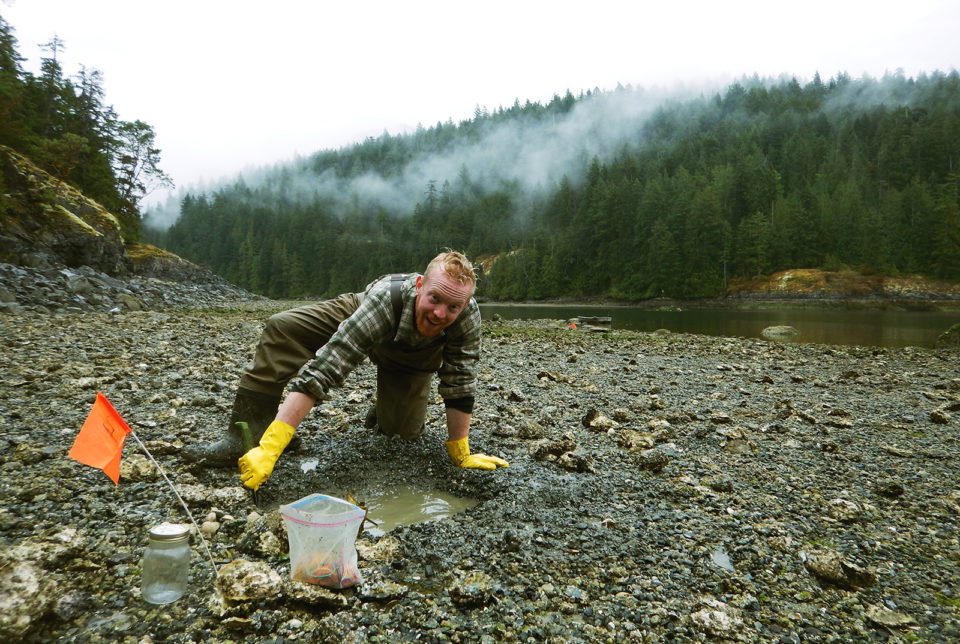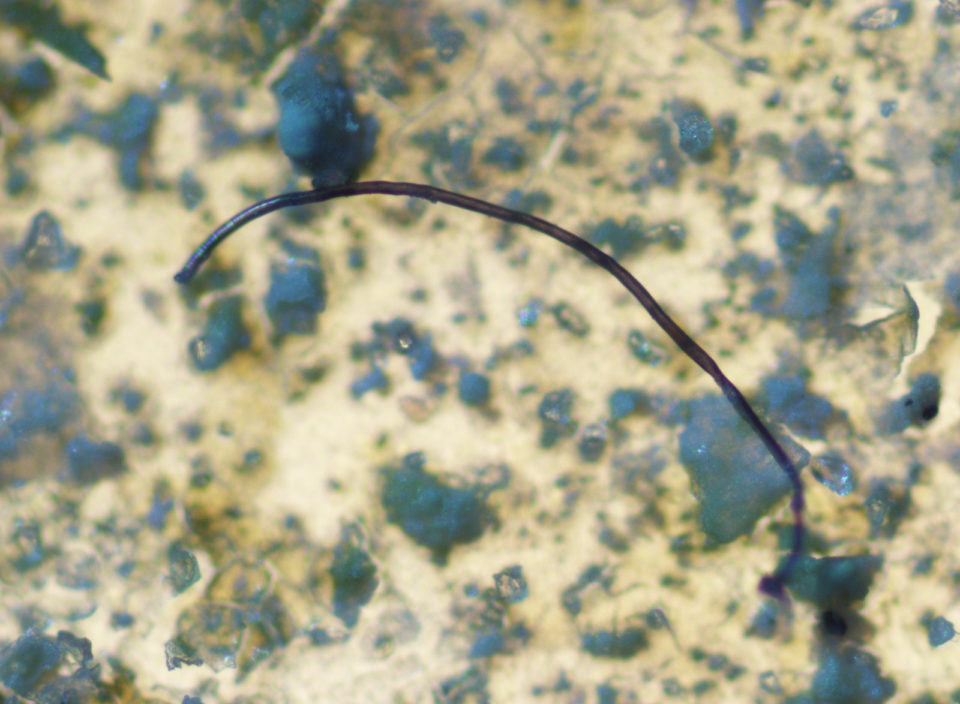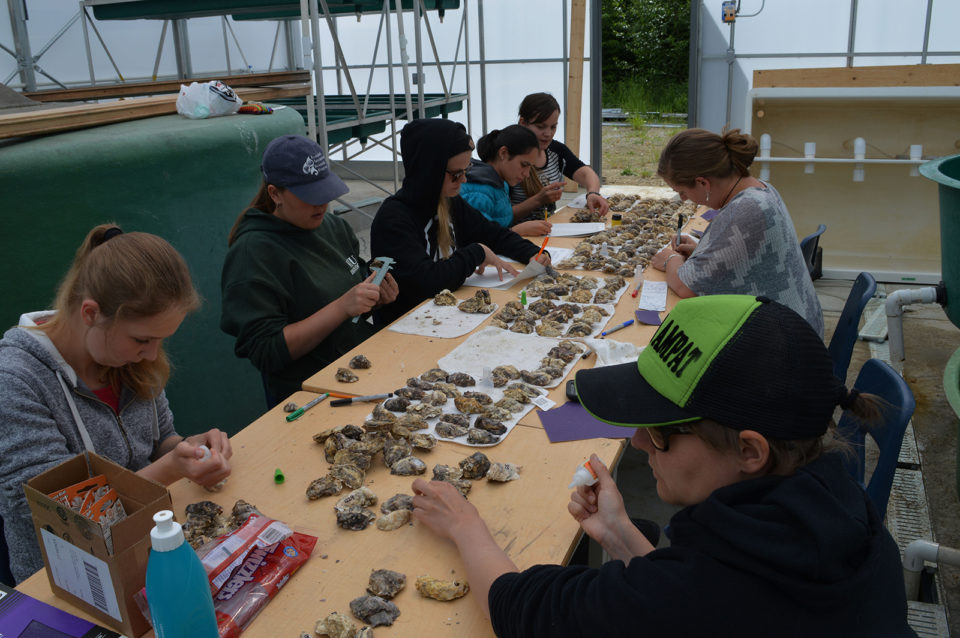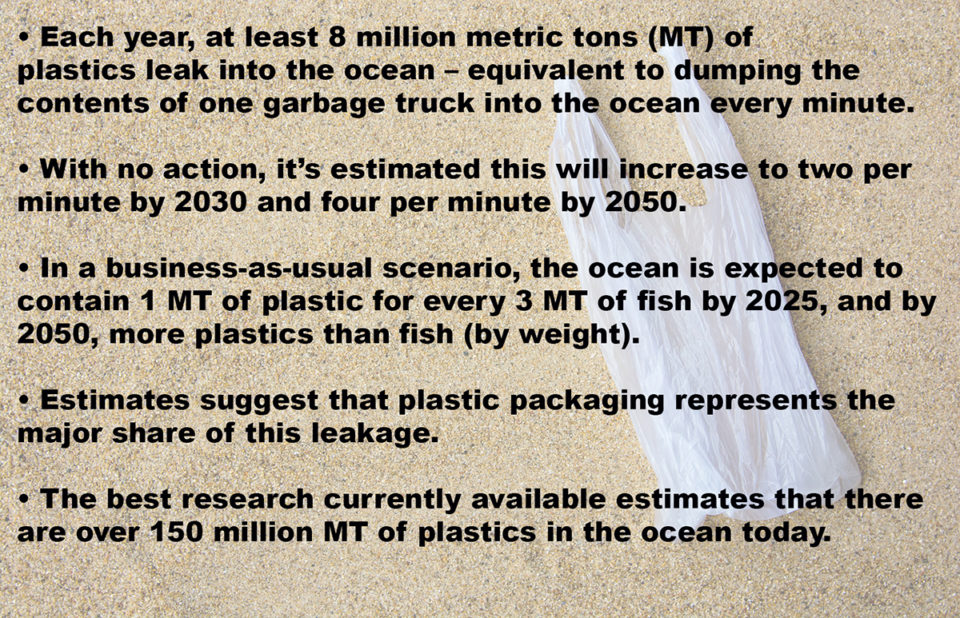Majority of reports about plastics in food supply focus on seafood, but lots of foods are at risk

Sarah Dudas, an ecologist in British Columbia, gives a lot of credit to the province’s shellfish-growing industry for funding scientific research into how plastic pollution is affecting the oysters and clams they grow.
“It puts them in a tricky spot,” said Dudas, an adjunct assistant professor at the University of Victoria, “because the aquaculture and fishery sectors use a lot of plastic and that plastic has the potential to pollute their own product. How much that actually happens has been one of the objectives of our study.”
Scientific research into the problem of plastic pollution – everyday plastics turning up in places where they can cause harm – is ramping up, an indicator that the problem is even more pervasive and insidious than previously understood. Public concern is growing, based on the volume of stories in the press and initiatives aimed at re-thinking how we use plastics.
Like all of society, aquaculture operators face questions regarding just how harmful this problem is to the marine environment in which it operates and what can and should be done about it. Also: How has the plastic in their operations contributed to plastic pollution? And is plastic pollution contaminating aquaculture products?
Microplastics are ‘everywhere’
“We wanted to know what was happening in the environment,” said Darlene Winterburn, executive director of the B.C. Shellfish Growers Association (BCSGA), which represents 70 percent of B.C. shellfish farmers, in an email. The association helped fund research to determine whether microplastics could be found in the marine environment and whether there were differences between remote and populated areas.
Figures on the cost and funding of the study were not available. Canada’s Department of Fisheries and Oceans paid for most of the cost through its Aquaculture Collaborative Research and Development Program. BCSGA’s contribution to the cost was “quite significant for our nonprofit,” said Winterburn.
Microplastics – small pieces of plastic less than 5 millimeters in size – include all kinds of plastics that were made to be small as well as pieces that have broken down from larger pieces of plastic, often in the marine environment. The term also covers microfibers, which are small bits of synthetic fibers that have been shed from things like ropes used in fisheries and aquaculture as well as synthetic fleeces and other clothing items as they are washed in household machines.
“The biggest takeaway from this research and the research of others around the globe that I’ve seen in the last year is that microplastics are everywhere,” said Winterburn. “There are small amounts in everything we consume. We live in a plastic society and, globally, each of us must reduce our use of single-use plastics.”
Single-use plastics – like utensils, cups, beverage bottles, straws and grocery bags – are now being banned in certain places. The United Kingdom, for example, saw usage of single-use plastic bags drop by 90 percent, or roughly 9 billion bags, after taxing them. Prime Minister Theresa May in late April announced a ban on single-use plastics, including straws and cotton swabs.
The EU has pledged that every piece of packaging will be reusable or recyclable by 2030.
For decades, people have known about plastic trash on beaches and the problem of marine animals becoming entangled in plastic debris. An understanding of the extent of the problem is what’s new, along with well-publicized images and reports of plastic trash found in the stomachs of marine creatures – and microplastics turning up in the human food supply.

Microplastics found in fish and shellfish
The majority of reports about plastics turning up in the human food supply focus on seafood, according to a 2017 report, Microplastics in Fisheries and Aquaculture, from the Food and Agriculture Organization of the United Nations (FAO).
“At present seafood appears to be the best studied source of dietary intake of microplastics,” said the report, citing a study from published by the European Food Safety Authority on the presence of microplastics and nanoplastics in food, with particular focus on seafood.
Nanoplastics are a subset of microplastics that are fewer than 100 nanometers (nm) in size. The ESA study reviewed the scientific literature of microplastics found in fish and shellfish from markets and the wild. One study sampled mussels (M. edulis), grown on a North Sea farm and Pacific oysters (C. gigas), reared in the Atlantic Ocean. Dr. Lisbeth Van Cauwenberghe and Dr. Colin R. Janssen of Ghent University published a 2014 study that found an average content of 0.36 and 0.47 particles per gram, respectively, in mussels and oysters.
A three-day depuration treatment decreased the microplastic content to .24 particles per gram of mussels and .35 particles per gram in oysters.
‘Exploding’ scientific interest in microplastics
The state of the science into microplastics, their little-known contamination of our food supply and the so-far-unknown effects of that on human health is “exploding” said Dudas.
“The reality is that plastic is likely in everything we’re eating,” said Dudas. “Few studies have been done on other foodstuffs yet but this work is increasing. I’m sure as more studies are done we will find it is in other types of food as well.”
As microplastics are found in more animals and the food supply, there are concerns for the effects on marine populations — and human health concerns.
Scientists Gerd Liebezeit and Elisabeth Liebezeit at the Institute for Chemistry and Biology of the Marine Environment in Wilhelmshaven, Germany, reported their findings on microplastic contamination found in beer in a 2014 paper published in Food Additives & Contaminants, and in sugar and honey in a 2013 paper published in the same journal.
Dr. Dongqi Yang led work on microplastic pollution of table salts in China, published in 2015 in Environmental Science & Technology. Dr. Ali Karami, at Universiti Putra in Malaysia, found microplastic particles in 17 salt brands from eight different countries.
The plastics themselves can cause adverse human health effects, as can chemicals like phthalates, flame retardants and bisphenol A, which are added to enhance plastics’ performance. These contaminants, absorbed over time, are known as persistent, bioaccumulative and toxic substances, according to FAO.

Comparing farmed and wild shellfish on Vancouver Island
In summer 2016, Dudas and her team grew Pacific oysters and Manila clams in the intertidal zone at both shellfish aquaculture sites and non-aquaculture sites around Okoer Inlet, primarily the southern Vancouver Island coast and some on the mainland. The researchers had previously worked with shellfish farmers in British Columbia who wanted to know if their products were contaminated by plastic used in their operations.
The researchers grew shellfish at a total of 36 sites: 10 aquaculture and 7 non-aquaculture sites for clams and for oysters 11 aquaculture sites and eight non-aquaculture sites. Then they tested the animals for microplastics.
On average, they found less than one particle of microplastic per animal and no difference between the animals grown in the aquaculture sites and those not grown in aquaculture sites, said Garth Covernton, a marine biology and ecology Ph.D. student on Dudas’ team at the University of Victoria. The number was considered low, and lower than reports of microplastics found in shellfish in other parts of the world.
Next, the team analyzed the particles and identified them as nylon and polyester and rayon – none of which matched the samples of ropes and nets from the nearby shellfish farms, said Covernton. Instead, they are most likely from synthetic clothing.
The particles Dudas, Covernton and the team found in the shellfish in British Columbia represent what’s become known as “background” microfibers either blowing through the air or water.
“They’re just everywhere we look,” said Covernton.
Concern for health of marine populations
“There’s definitely no doubt that when we eat seafood, we eat microplastics,” said Chelsea Rochman, assistant professor in the Department of Ecology and Evolutionary Biology at the University of Toronto.
And the plastics are coming from everywhere, she said. “There are so many different sources, we can’t pinpoint a source,” said Rochman, “Which is why there’s not just one solution to this problem.”
In 2014, Rochman sampled fish and shellfish purchased at markets in Indonesia and at oysters purchased at markets in California. She found microplastics in the gut of one in four animals in both places.
The evidence of physiological effects on fish and shellfish so far is inflammation, tumor promotion and disruption to the endocrine system, which leads to reduced reproductive success, said Rochman.
Overall, said Rochman, the initial answers are mixed on the health effects of microplastics on animals, and it’s difficult to replicate the combination and amounts of plastics animals are exposed to in the lab. Scientists have been working toward a meta-analysis to summarize the state of the science and studies about the effects of microplastics on marine animal health.
“This is not a time when people who have aquaculture farms need to be freaking out,” said Rochman.
But, she advised, aquaculture operators can and should ask questions, work with scientists, and think about their use of plastic. Along with everyone else, aquaculture operators should reduce their use of plastic.
“My takeaway from this,” said Dudas, “is that as an aquaculturist you should be aware of this issue and you should find out the answers for your area using your gear. Given the fact that the research coming from different areas shows different and often conflicting results suggests it’s context-specific, based on the gear you’re using and the environment you’re in.”
Concern for human health
The tricky part for the shellfish-growing industry is that when National Public Radio reported the story about Dudas’ work in September 2017, the headline was: Guess What’s Showing Up In Our Shellfish? One word: Plastics.
The headline was accurate. But the more microplastics are studied, the more they will be found in other types of food, said Dudas – who notes that, in context with seafood’s health benefits, there is no reason to avoid it.
“Our research has not affected how much seafood I eat at all,” said Dudas. “Not a bit. Because the benefits of eating shellfish and finfish and all of the micronutrients and fat and all of the goodness that’s in seafood far outweigh any of the known risks of eating microplastics.”
Human intake of microplastics from seafood is estimated to be between one particle per day to 30 particles per day, according to FAO. Much can be avoided since people generally do not eat the digestive tract of marine animals, except for bivalves, echinoderms like urchins and some small fish.
FAO estimated the worst–case exposure to microplastics after eating a portion of mussels to be 7 micrograms of plastics, and that would have a negligible effect on the person’s exposure to persistent, bioaccumulative and toxic substances that are absorbed the plastic over time.
But that’s for now. One cause for concern, noted Dudas, is that scientists cannot detect plastics smaller than 100 microns.
“That sounds small, but that’s quite big,” she said. “We don’t have a good handle on that.”
If we ingest plastics that are 100 to 200 microns, they will most likely pass through the digestive system. But particles 30 to 40 microns and smaller can cross cell membranes – and there is no way to measure them now.
“It’s a black box,” Dudas said.
Also, unless there are big changes to the status quo, plastic contamination is only increasing.

State of the science
Plastic is now considered to be a globally ubiquitous pollutant. Contamination likely began in the first half of the 20th century and the first reports of plastic contamination from debris of various sizes date to the 1960s, according to FAO.
All kinds of plastic breaks down into ever-smaller pieces. But it never really goes away. Plastic production is only increasing, reaching 322 million tons in 2015 and estimated to double by 2025 and triple by 2050. An estimated 4.8 to 12.7 million tons of plastics entered the ocean in 2017. If waste management practices continue to be status quo, that amount is estimated to increase ten-fold in the next decade, said FAO.
Both sea and land-based activities are responsible for marine litter/marine debris.
“At present there are no current global estimates of the contribution of fisheries and aquaculture to total plastic waste in aquatic environments,” said the FAO report. “The shellfish culture industry appears to be a major contributor to shoreline debris including EPS floats, plastic net sheets, bags, ropes and baskets,” said the report, noting other derelict gear from other types of operations.
An estimated 1 million seabirds and more than 100,000 marine mammals die because of plastic debris every year, according to UNESCO, the United Nations Educational Scientific and Cultural Organization.
Managing microplastics
One way aquaculture operators can manage what will be an increasingly prevalent and publicized problem is to consider the types of plastics they use.
There is some evidence of polymers that are more inert than others, said Rochman. Polyethylene and polypropylene, for example, tend to be more inert than polyvinyl chloride (PVC) and polystyrene.
Dudas recommends aquaculture producers get ahead of the problem, work with researchers and find out the specifics on what microplastics may be in their products. That’s why she applauds BCSGA for taking a proactive stance. That will help them in the long run, she said.
Winterburn, from the association, notes a huge industry push in recent years to replace open Styrofoam and the industry has been encouraging people with private docks, float homes and work floats to do the same.
“We have farmers up and down our coasts who, in addition to maintaining their farms, have organized semi-annual or annual beach cleanups for decades,” said Winterburn.
Given what’s already known – plus what’s still unknown – there is no need to wait to reduce use of plastic wherever possible, said Dudas. As a society, she noted, we’ve been irresponsible about using plastic and this must change. She recently recorded a TedX Talk on the topic, and how it affects everyone.
Using numbers from a recent study, for example, Dudas calculated that her family of four releases 1.1 billion microfibers through the household washing machine, simply by washing fleeces and other synthetic clothing.
“In my mind, any industry that uses plastic has an opportunity to reduce or change the way that they use it,” said Dudas. In time, that information will be impactful with consumers.
“I make my seafood choices based on where things come from and how things are cultured and raised,” said Dudas. “If I had a choice to buy shellfish from a company that was making an effort to reduce its plastic pollution, I would. You bet.”
Follow the Advocate on Twitter @GAA_Advocate
Author
-

Lisa Duchene
Lisa Duchene is a freelance conservation science writer, editor and communications consultant based in central Pennsylvania. She has written about the marine environment for more than two decades.
Tagged With
Related Posts

Intelligence
Omega-6s and the threat to seafood’s healthy halo
Research shows farmed fish fed diets heavy on vegetable oils have higher amounts of omega-6s and lower amounts of omega-3s, compared to fish fed diets heavy on fish oil. We take a deep dive into the relationship between the two fatty acids.

Innovation & Investment
Thinking outside the cage: Avant-garde aquaculture in Norway
Salmon farming in Norway is poised for an innovation boom. The biggest players are putting cutting technology in the water to solve some of the industry’s most persistent problems, such as sea lice, fish escape and waste management.

Health & Welfare
Chem-free fixes emerging in sea lice saga
Salmon farmers, using emerging technologies, are exploring new methods of sea lice mitigation in an effort to overcome one of the industry’s most persistent problems. New chemical-free innovations show an industry eager to adapt and adopt environmentally safe practices.

Responsibility
Warming oceans prompt adaptation efforts for aquaculture
A five-year study in Canada aims to provide more answers about warmer waters with lower oxygen levels and a way for farmed fish producers to adapt to climate change.

